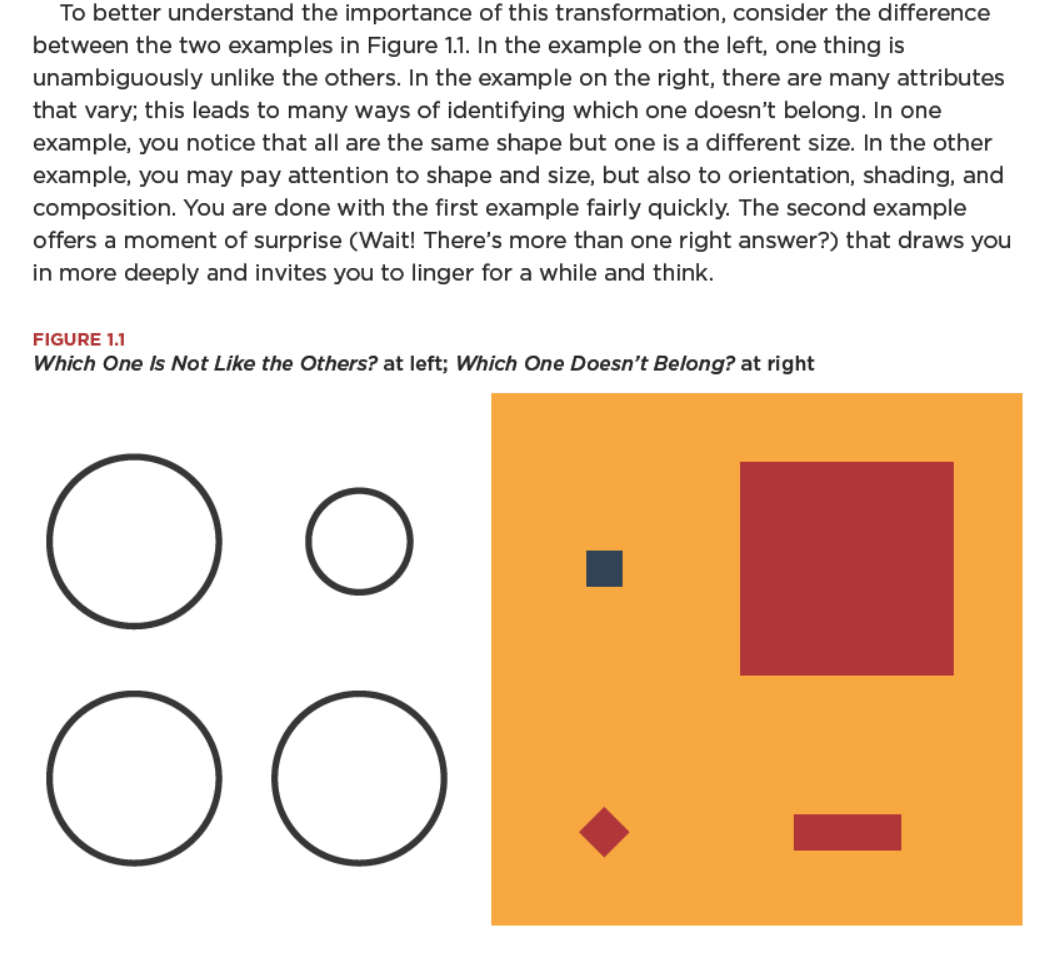 By Marti Smith
By Marti Smith
 I recently had the privilege of sharing Christopher Danielson’s book Which One Doesn’t Belong with my 5th grade math classes. Each page in his deceptively simple layout has four different figures. He asks the readers to choose “which one doesn’t belong” and tell why.
I recently had the privilege of sharing Christopher Danielson’s book Which One Doesn’t Belong with my 5th grade math classes. Each page in his deceptively simple layout has four different figures. He asks the readers to choose “which one doesn’t belong” and tell why.
There’s also an accompanying teacher’s guide, with teaching ideas across the grades from kindergarten to high school. (Look inside the guide here.)
I thought the WODB activity might generate some interesting conversations and serve as a review for our geometry unit which we were concluding. So we gave it a try!
Excerpted from Which One Doesn’t Belong, Teacher’s Guide (Stenhouse Publishers, 2016)
Some of our observations
Even though the book says “every answer can be correct,” my students had a hard time believing that two, three, or four different answers could all be correct. We decided to find out!
We started off with the first set of figures and I asked everyone to think silently about which figure didn’t belong. I called on Noah to share his thoughts. Noah chose a figure and explained why that figure was different than the rest.
Sarah quickly chimed in saying, “I disagree! I think the third figure doesn’t belong.” She gave her reasons for choosing the third figure. After several of these disagreements, I asked the students to think about why they disagree. I asked them if they understood Noah’s reasoning. They all agreed that, based on Noah’s reasoning, he was correct.
They also agreed that Sarah’s reasoning was correct. One student then said, “You mean we are all correct?” The conversation had reached a turning point. As we explored more sets of figures, I didn’t hear, “I disagree” or “I think you’re wrong”. Instead, I heard “ Wow, I didn’t think of that” and “I saw something different”.
https://www.youtube.com/watch?v=Gpc8Uunci14&feature=youtu.be
A WODB chat at Hibbett Middle School
Another observation I found very interesting was how students borrowed vocabulary from one setting and tried to apply (maybe misapply) it to a new setting. Have you ever heard of a scalene quadrilateral? Neither had I!
But I knew what the student meant, and so did the rest of the class. When I asked him to explain, he said a scalene triangle is a triangle with all three sides having different lengths. A scalene quadrilateral, therefore, is a quadrilateral with all four sides having different lengths.
Makes sense, doesn’t it? But, is it mathematically correct? I don’t know. My students gave me some pretty good arguments justifying their reasoning! We decided we needed to do some research on the word scalene. Does it only apply to triangles?
Listen to Christopher Danielson talk about the ideas behind his book.
Planning for next year
I plan to continue exploring this book and use it again next year, but with a few changes. I think it would be very beneficial to do this activity first, as a pre-assessment to our geometry unit. What do they already know? What misconceptions do they have?
At the conclusion of the unit, I would like to repeat the activity and see how their answers and explanations change. Will I see any growth in their vocabulary? Will they notice new differences based on the properties of the figures?
I think it would also be very interesting to have the students write their own reflections. Did they find this activity interesting and why? What do they think they learned from this activity?
My classes thoroughly enjoyed this book and our conversations about shapes. It generated deep thinking and brought up a few questions that we are still wondering about. In a good way!
Further Reading: “How I Learned to Love Middle School Geometry” (Christopher Danielson)
Marti G. Smith teaches fifth grade math and reading at Hibbett Middle School in Florence, Alabama. She grew up in Tucson, Arizona. (Thanks to Krissy O. Edwards, HMS Instructional Partner, for creating the video!)


0 Comments on "An Innovative Math Book Sparks Some Great Class Chat about Geometry"